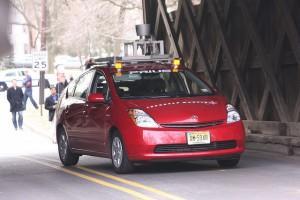 Ah, the driverless car. As Google and other companies are beginning in earnest to develop driverless cars, much has been written on the subject. The cars are hailed for their potential to reduce accidents and congestion and to provide a means of travel for the disabled and the elderly (not too different than a bus or train, but I digress). The discussion everyone seems to be having is, how will the driverless car impact the design of cities? Will there be more empty parking spots? Will more people move to the exurbs because they will be able to work during their commute? But there’s a driverless car topic that has yet to enter the conversation but could have huge implications for the public’s health: with rising rates of obesity and diabetes, do we really want the way of the future to be a sedentary one?
Ah, the driverless car. As Google and other companies are beginning in earnest to develop driverless cars, much has been written on the subject. The cars are hailed for their potential to reduce accidents and congestion and to provide a means of travel for the disabled and the elderly (not too different than a bus or train, but I digress). The discussion everyone seems to be having is, how will the driverless car impact the design of cities? Will there be more empty parking spots? Will more people move to the exurbs because they will be able to work during their commute? But there’s a driverless car topic that has yet to enter the conversation but could have huge implications for the public’s health: with rising rates of obesity and diabetes, do we really want the way of the future to be a sedentary one?
Today, many transportation advocates are working to design cities and streets such that they promote walking and biking. Numerous cities across the country have passed Complete Street policies, which require that all new streets be built for all users. That is, cities are slowly but surely moving away from the car as dominant model; bikes, pedestrians and buses are starting to earn a real place at the “dinner table” (the city street), if you will. Why? Because there are tremendous economic, social and health benefits to encouraging and facilitating the use of modes of transportation other than the car. For example, something as simple as walking to the bus or the train is a great way to meet the recommended levels of daily physical activity.
But no one seems to be talking about the fact that if we’re re-idolizing the car, in the form of a driverless one, that is, what happens to encouraging biking and walking to destinations and to designing communities that support these behaviors? What happens to all that exercise?
Health typically enters the driverless car conversation when the talk is about how removing humans from behind the wheel should reduce car accidents. Ezra Klein, in the Washington Post, offered that full adoption of driverless cars could cut the number of car accidents in half, which would lead to a significant reduction in health care costs.
This is huge, but health is a lot more than just avoiding accidents. It’s biking. It’s walking. It’s exercise. It’s talking to your neighbors. It’s the cast of characters you meet on the bus. It’s all the things you don’t get when a driverless car picks you up at your door and takes you directly to your destination.
What’s more, experts are predicting that because so much can be accomplished on the journey in a driverless car from Point A to Point B, the commute will no longer be a burden so people will move to the exurbs. Longer commutes mean more sitting (not to mention, an increase in gas and electricity used). And when you add that to the sitting (and electricity and gas use) we do all day at work, well, that’s a lot of sitting when what we really need to be doing is moving, exercising and socializing.
Driverless cars won’t hit the road for a while and they could be great for the environment. Regardless of their many benefits, it’s important that we think about how we’re framing the conversation around them, and, specifically, where health fits in. It’s imperative that health- in its most broad sense- be a part of the discussion. Transportation decisions impact health. Promoting the car, whether it’s a driverless car or a regular old man-operated motor vehicle, at the expense of exercise will have health consequences. The public health community needs to enter into the conversation about driverless cars before the cars hit the road without them.




